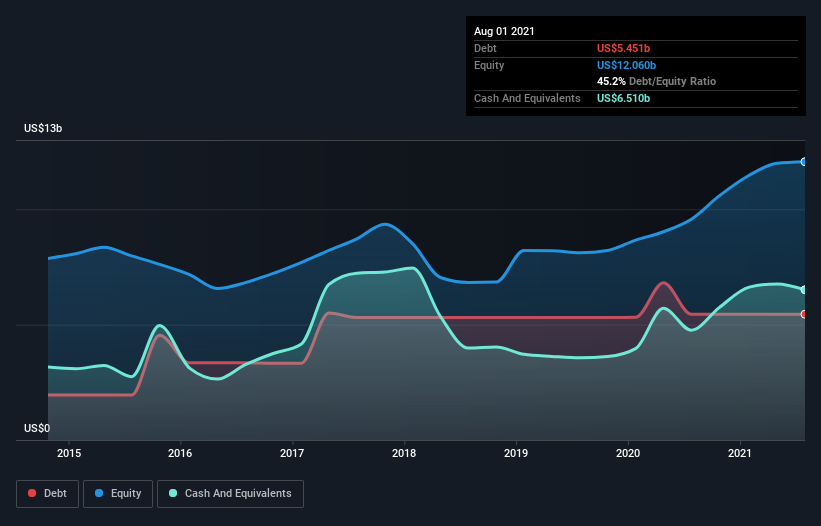These 4 Measures Indicate That Applied Materials (NASDAQ:AMAT) Is Using Debt Safely
Legendary fund manager Li Lu (who Charlie Munger backed) once said, 'The biggest investment risk is not the volatility of prices, but whether you will suffer a permanent loss of capital.' When we think about how risky a company is, we always like to look at its use of debt, since debt overload can lead to ruin. We can see that Applied Materials, Inc. (NASDAQ:AMAT) does use debt in its business. But should shareholders be worried about its use of debt?
Why Does Debt Bring Risk?
Debt and other liabilities become risky for a business when it cannot easily fulfill those obligations, either with free cash flow or by raising capital at an attractive price. Ultimately, if the company can't fulfill its legal obligations to repay debt, shareholders could walk away with nothing. While that is not too common, we often do see indebted companies permanently diluting shareholders because lenders force them to raise capital at a distressed price. Having said that, the most common situation is where a company manages its debt reasonably well - and to its own advantage. When we examine debt levels, we first consider both cash and debt levels, together.
See our latest analysis for Applied Materials
What Is Applied Materials's Net Debt?
The chart below, which you can click on for greater detail, shows that Applied Materials had US$5.45b in debt in August 2021; about the same as the year before. But it also has US$6.51b in cash to offset that, meaning it has US$1.06b net cash.
How Strong Is Applied Materials' Balance Sheet?
Zooming in on the latest balance sheet data, we can see that Applied Materials had liabilities of US$5.13b due within 12 months and liabilities of US$7.29b due beyond that. Offsetting this, it had US$6.51b in cash and US$3.99b in receivables that were due within 12 months. So its liabilities total US$1.92b more than the combination of its cash and short-term receivables.
Having regard to Applied Materials' size, it seems that its liquid assets are well balanced with its total liabilities. So while it's hard to imagine that the US$127.5b company is struggling for cash, we still think it's worth monitoring its balance sheet. While it does have liabilities worth noting, Applied Materials also has more cash than debt, so we're pretty confident it can manage its debt safely.
On top of that, Applied Materials grew its EBIT by 61% over the last twelve months, and that growth will make it easier to handle its debt. When analysing debt levels, the balance sheet is the obvious place to start. But ultimately the future profitability of the business will decide if Applied Materials can strengthen its balance sheet over time. So if you want to see what the professionals think, you might find this free report on analyst profit forecasts to be interesting.
Finally, a business needs free cash flow to pay off debt; accounting profits just don't cut it. While Applied Materials has net cash on its balance sheet, it's still worth taking a look at its ability to convert earnings before interest and tax (EBIT) to free cash flow, to help us understand how quickly it is building (or eroding) that cash balance. Over the most recent three years, Applied Materials recorded free cash flow worth 78% of its EBIT, which is around normal, given free cash flow excludes interest and tax. This free cash flow puts the company in a good position to pay down debt, when appropriate.
Summing up
We could understand if investors are concerned about Applied Materials's liabilities, but we can be reassured by the fact it has has net cash of US$1.06b. And it impressed us with its EBIT growth of 61% over the last year. So we don't think Applied Materials's use of debt is risky. There's no doubt that we learn most about debt from the balance sheet. But ultimately, every company can contain risks that exist outside of the balance sheet. These risks can be hard to spot. Every company has them, and we've spotted 2 warning signs for Applied Materials you should know about.
At the end of the day, it's often better to focus on companies that are free from net debt. You can access our special list of such companies (all with a track record of profit growth). It's free.
This article by Simply Wall St is general in nature. We provide commentary based on historical data and analyst forecasts only using an unbiased methodology and our articles are not intended to be financial advice. It does not constitute a recommendation to buy or sell any stock, and does not take account of your objectives, or your financial situation. We aim to bring you long-term focused analysis driven by fundamental data. Note that our analysis may not factor in the latest price-sensitive company announcements or qualitative material. Simply Wall St has no position in any stocks mentioned.
Have feedback on this article? Concerned about the content? Get in touch with us directly. Alternatively, email editorial-team (at) simplywallst.com.

 Yahoo Finance
Yahoo Finance 
